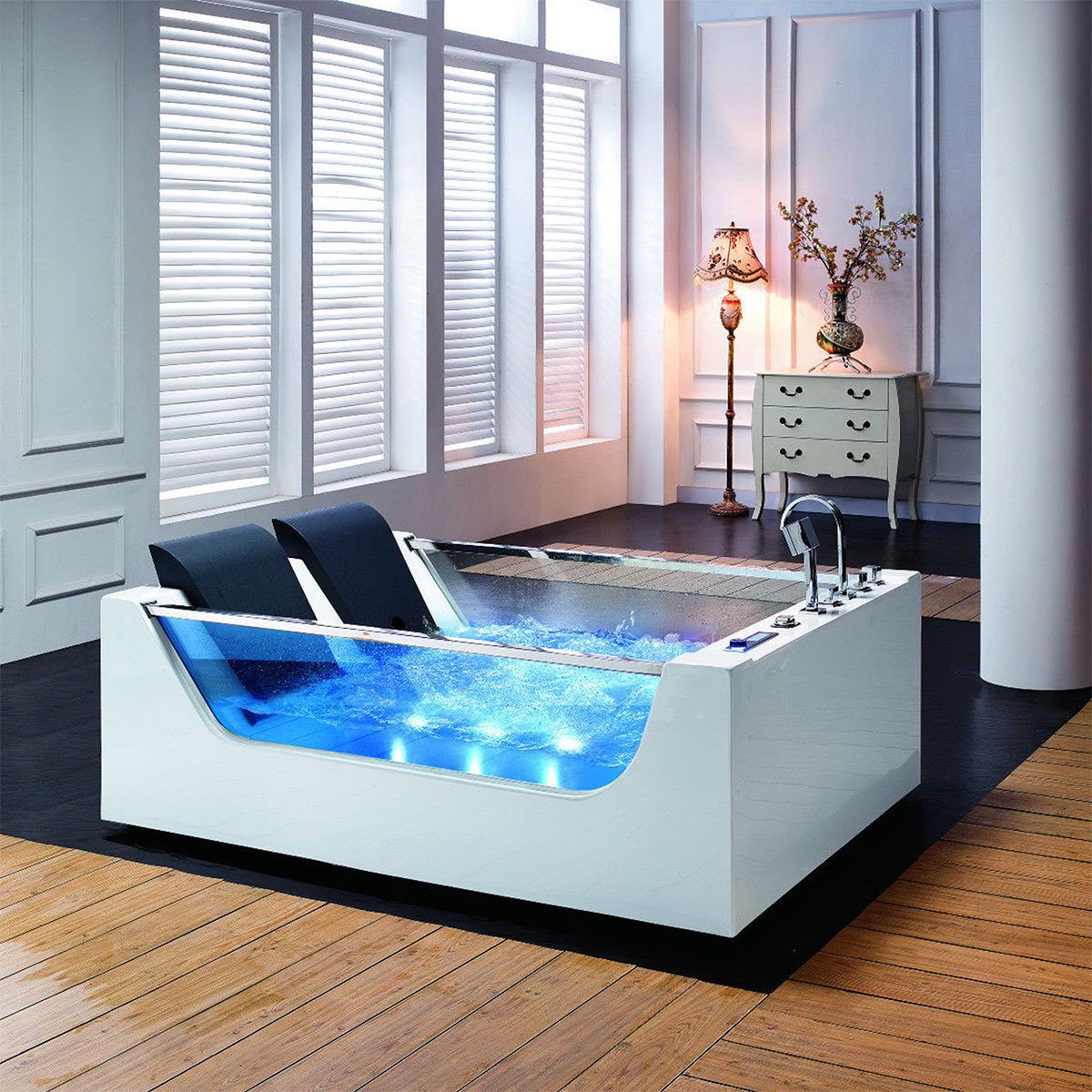Stepping Up Your Bathroom Game with a Modern Tub
Fancy upgrading your bathroom with a fancy new tub? Modern tubs are more than just bathroom fixtures; they’re sculptural centerpieces that elevate your space from functional to fabulous. Whether you’re dreaming of a sleek, freestanding soaking tub or a modern take on the classic alcove design, this comprehensive guide will help you navigate the world of modern tubs and create your perfect bathroom sanctuary.
Let’s Talk Tub Types
Think of this as choosing the shape of your relaxation haven:
- Freestanding Tubs: Imagine a beautiful sculpture in your bathroom – that’s the vibe these tubs give off. They’re independent, stylish, and scream “luxury.” Plus, you can place them almost anywhere.
- Alcove Tubs: Remember the classic bathtub tucked between two walls? Alcove tubs are like their cooler cousins. They’re sleek, modern, and come with all the latest features.
- Walk-in Tubs: These are all about making life easier and safer, especially for those with mobility issues. No more awkwardly climbing over the edge! And the best part? They don’t skimp on style.
Deciphering the Materials: What’s Your Tub Made Of?
The material you choose is a big deal – it impacts everything from how warm the water stays to how easy your tub is to clean:
| Material | Pros | Cons |
|---|---|---|
| Acrylic | Budget-friendly, Easy to Clean, Lightweight | Might not be as durable as others |
| Solid Stone Resin | Looks like natural stone, Super durable, Holds heat well | Can be a bit heavier, Might cost a bit more |
| Copper | Absolutely stunning, Naturally antimicrobial | Requires some upkeep to stay shiny |
Things to Keep in Mind Before You Buy
Before you fall in love with a tub at first sight, consider these points:
- Size and Space: Measure twice, relax once! Be realistic about your bathroom’s size and choose a tub that fits comfortably.
- Material and Durability: Think about your lifestyle and budget. Do you need a tub that can handle daily wear and tear?
- Features: Want jets that massage your worries away? Or maybe a built-in heater for extra-long soaks? Knowing what features you want will make your decision easier.
Where to Find Your Dream Tub
Here’s the good news: you don’t have to search far and wide!
- Trusted Brands: Names like American Standard, Kohler, and Jacuzzi are well-known for a reason – they make high-quality tubs that last.
- Big Retailers: Stores like Home Depot, Lowe’s, and Wayfair offer a huge selection and good deals.
Don’t Forget Installation and Maintenance
- Call the Professionals: Unless you’re a plumbing whiz, get your tub professionally installed. It’s worth the peace of mind!
- Keep it Sparkling: Every tub material has its own cleaning needs. A little TLC goes a long way in keeping your tub looking its best.
Decoding the Price Tag: How Much Does a New Tub Cost?
So, you’re ready to dive into a mountain of bubble bath, but what about the price tag? Just like choosing the perfect bath bomb, figuring out your tub budget can be a bit bubbly—meaning it can really vary!
You might find a basic tub starting around $400, but that’s likely just the tub itself. The real cost can climb higher than a rubber ducky in a hurricane, sometimes exceeding $16,000! On average, people spend around $5,000 for their dream soak setup.
What Makes the Price Go Up and Down?
Tub Types: From Standard to Spa-tastic
The type of tub you choose significantly impacts the overall cost. Here’s a breakdown:
- Alcove Tubs: These classic tubs, nestled within a three-wall alcove, are the most common and generally the most affordable, starting around $400.
- Freestanding Tubs: A symbol of luxury and design, freestanding tubs command a higher price, often starting around $1,500 and reaching upwards of $10,000 for high-end models.
- Walk-In Tubs: Designed for accessibility, walk-in tubs typically range from $2,000 to $5,000, depending on features and customization.
- Whirlpool Tubs: If you’re looking for a spa-like experience with massaging jets, be prepared to shell out anywhere from $1,000 to $7,000 or more.
- Air Tubs: Offering a gentler massage than whirlpool jets, air tubs tend to be priced between basic and whirlpool tubs, averaging around $1,000 to $4,000.
Materials: From Budget-Friendly to Bougie
The material of your tub also plays a crucial role in determining the price:
- Acrylic: A popular choice for its affordability, durability, and ease of maintenance, acrylic tubs generally range from $400 to $2,000.
- Fiberglass: Similar in price and characteristics to acrylic, fiberglass tubs offer another budget-friendly option, typically priced between $500 and $2,500.
- Porcelain-Enameled Steel: Known for its durability and resistance to scratches and stains, porcelain-enameled steel comes at a higher price, usually ranging from $600 to $3,000.
- Cast Iron: The gold standard for heat retention and classic style, cast iron tubs are the most expensive option, often starting at $2,000 and reaching upwards of $10,000 or more.
Fancy Features: Jets, Lights, and Oh My!
Adding extra features like massaging jets, built-in heaters, mood lighting, or even sound systems can significantly increase the cost of your tub.
Installation: Don’t Forget the Pros!
Unless you’re a DIY pro, you’ll likely need a plumber to install your fabulous new tub. Installation costs can range from $1,000 to $8,000, depending on the complexity of the job and your location.
Refinishing: The Budget-Friendly Makeover
If you’re happy with your current tub’s shape and size but crave a fresh look, refinishing might be your new best friend! This process involves applying a new surface to your existing tub, making it look brand-new without the hefty price tag of a full replacement. Refinishing usually costs between $250 and $600.
The Bottom Line: Finding Your Tub Budget Sweet Spot
Just like finding the perfect water temperature, figuring out your tub budget takes a little experimentation. Consider what’s important to you – do you crave luxurious features or is a simple, budget-friendly soak more your style?
Once you have a good grasp on your priorities and budget, you’ll be well on your way to enjoying your very own slice of bath time bliss!
Acrylic Tubs: Unveiling the Drawbacks
Acrylic tubs are often praised for their affordability, lightweight design, and versatility. However, it’s essential to weigh the pros and cons before you dive in. Let’s take a closer look at some potential disadvantages of acrylic tubs:
- Susceptibility to Scratches and Stains: Acrylic’s softer surface, while comfortable, is more prone to scratches and stains compared to more robust materials like porcelain or enamel.
- Fading Color: Over time, exposure to sunlight and harsh cleaning chemicals can cause the color of acrylic tubs to fade, particularly in lighter shades.
- Potential for Flexing: While generally sturdy, acrylic tubs might flex slightly under weight, which some users may find unnerving.
- Lower Heat Retention: Acrylic doesn’t retain heat as effectively as materials like cast iron, meaning your bathwater might cool down faster.
- Repair Challenges: While repairable, scratches and cracks in acrylic tubs can be more noticeable even after professional fixing.
Soaking Tub vs. Bathtub: Unraveling the Differences
While the terms “soaking tub” and “bathtub” are often used interchangeably, some key differences set them apart. Understanding these distinctions can help you choose the perfect tub for your needs.
-
Depth and Immersion: Soaking tubs are deeper than standard bathtubs, allowing for full-body immersion. This deeper water level promotes relaxation and helps relieve muscle tension.
-
Purpose and Design: Soaking tubs are specifically designed for relaxation and therapeutic benefits. They often feature ergonomic designs, contoured shapes, and additional features like armrests and headrests for added comfort. In contrast, bathtubs prioritize functionality, focusing on efficient bathing and water usage.
-
Features and Enhancements: Soaking tubs often come equipped with luxurious features like massaging jets, built-in heaters, aromatherapy systems, and chromatherapy lighting to enhance the spa-like experience. Bathtubs, on the other hand, typically have a more basic design.
- How to Get Rid of Mushrooms in Your Lawn: A Complete Guide - April 24, 2025
- How to Get Rid of Ground Hornets: A Safe and Effective Guide to Eliminating Nests - April 24, 2025
- How to Get Rid of German Roaches Fast: DIY Methods for Quick Control - April 24, 2025










